Spain is calling travelers worldwide, and discovering the Best Places to Visit in Spain 2025-2026 is the perfect way to plan an unforgettable journey. From lively cities to hidden villages, the Best Places to Visit in Spain 2025-2026 highlight world-class art, rich traditions, and breathtaking coastlines. Whether exploring the Gothic streets of Barcelona or the Alhambra in Granada, the Best Places to Visit in Spain 2025-2026 blend history with modern charm.

For beach lovers, Ibiza and Mallorca shine, while culture seekers will adore Seville and Madrid. Food, festivals, and heritage add more reasons why the Best Places to Visit in Spain 2025-2026 remain at the top of every traveler’s bucket list. With so many choices, planning around the Best Places to Visit in Spain 2025-2026 ensures your trip is both rewarding and memorable. This guide takes you through the Best Places to Visit in Spain 2025-2026, with itinerary tips, hidden gems, and affordable options for every traveler.
Best Places to Visit in Spain 2025-2026
Spain continues to stand out as one of Europe’s most rewarding destinations, offering a mix of lively cities, historic landmarks, and coastal escapes. The best places to visit in Spain in 2025 and 2026 include world-famous cities like Madrid, Barcelona, and Seville, as well as hidden gems such as Cuenca, Girona, and the dramatic Picos de Europa mountains. Whether someone seeks art, food, beaches, or festivals, Spain delivers a wide range of experiences that fit every style of travel.
Travelers planning a Spain itinerary for 10 days can balance cultural highlights with time to relax. A trip might include the museums of Madrid, the Alhambra in Granada, the beaches of Valencia, and the nightlife of Ibiza. For those on a budget, the cheapest places to travel in Spain in 2026 include smaller cities and inland regions where authentic food and local traditions remain affordable.

Beyond the main attractions, Spain’s cultural calendar makes each trip unique. Festivals in 2025 and 2026, such as Semana Santa in Seville and La Tomatina in Buñol, showcase the country’s traditions in unforgettable ways. Choosing between Spain’s beaches and cities depends on personal preference, but both offer strong reasons to visit—coastal towns bring relaxation while cities highlight history, art, and vibrant street life.
Top Destinations and Attractions in Spain for 2025 and 2026
Spain offers a wide range of experiences, from historic cities filled with UNESCO World Heritage Sites to coastal towns with Mediterranean beaches. Travelers can explore world-class museums, Moorish palaces, and Gothic cathedrals, or head to the islands for natural beauty and nightlife.
Essential Cities: Barcelona, Madrid, Seville, Granada, Valencia
Barcelona stands out for its mix of culture and architecture. Visitors often head to Antoni Gaudí’s Sagrada Família and Park Güell, both iconic landmarks of Catalonia. The Barceloneta Beach and the Gothic Quarter also remain popular.
Madrid combines history and art. The Prado Museum, Royal Palace, and Retiro Park make it one of the best places to visit in Spain. Its Plaza Mayor and lively neighborhoods offer plenty of dining and nightlife.
Seville attracts travelers with the Real Alcázar, Plaza de España, and the Santa Cruz quarter. Flamenco shows and Andalusian cuisine add to its appeal.
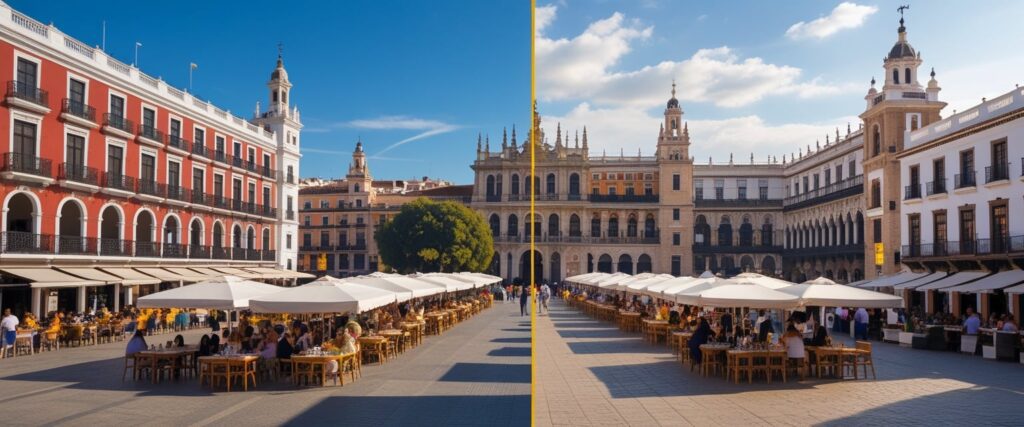
Granada is best known for the Alhambra and the Albaicín district. The Moorish influence is clear in its architecture and winding streets.
Valencia blends tradition and modern design. The City of Arts and Sciences is its most famous landmark, while the Valencia Cathedral and lively markets showcase its history and food culture.
Iconic Landmarks and Museums
Spain’s landmarks highlight its layered history. The Mezquita of Córdoba shows Islamic design alongside Christian elements. Toledo, known as the “City of Three Cultures,” reflects Jewish, Muslim, and Christian heritage.
In Segovia, the Roman aqueduct and Alcázar de Segovia stand out. The Puente Nuevo bridge in Ronda spans the dramatic El Tajo Gorge.
Art lovers can explore the Picasso Museum in Málaga, the Guggenheim Museum in Bilbao, and the Dalí Theatre-Museum in Figueres.
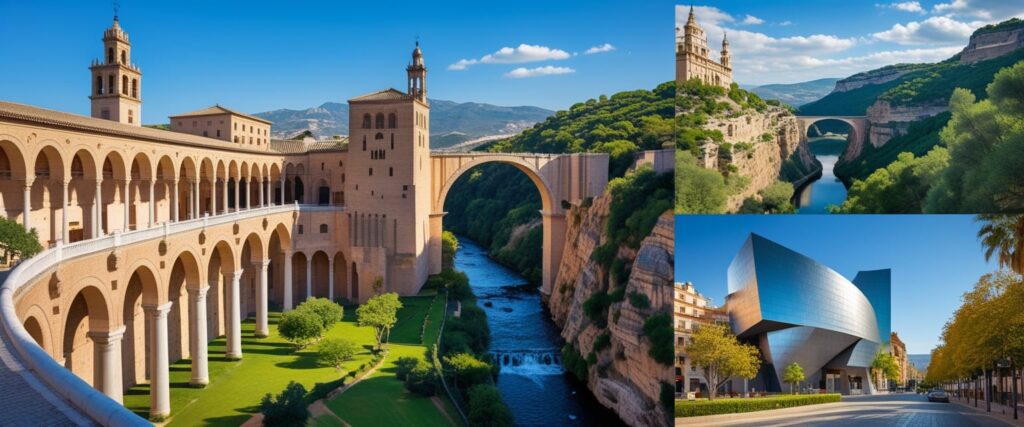
Other must-sees include Santiago de Compostela Cathedral in Galicia, the Gothic Cathedral of Burgos, and Zaragoza’s Basilica of Our Lady of the Pillar and Aljafería Palace.
Best Spanish Beaches and Islands
Spain’s coastline and islands offer both lively resorts and quiet escapes. The Costa del Sol and Costa Brava provide sandy beaches and seaside towns like Lloret de Mar.
The Balearic Islands—Mallorca, Menorca, and Ibiza—attract visitors with turquoise waters, nightlife, and historic sites like Dalt Vila in Ibiza. Palma de Mallorca offers a Gothic cathedral and harbor views.
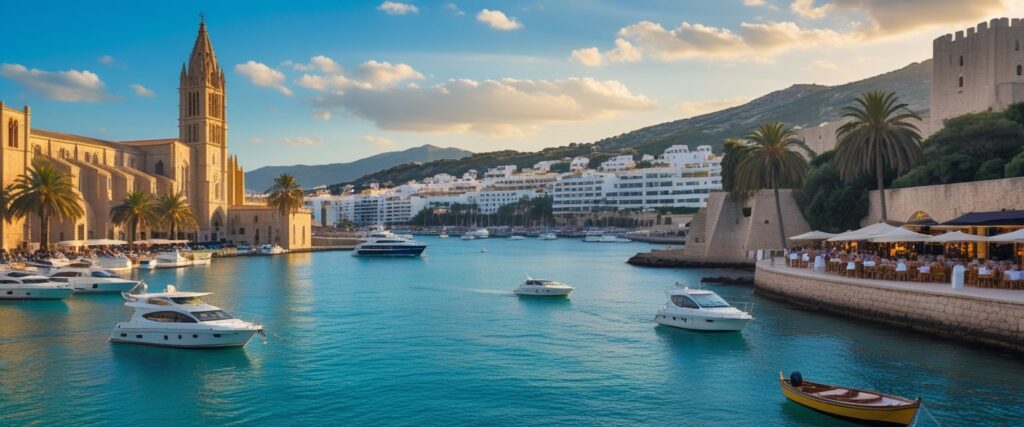
The Canary Islands, including Tenerife and Gran Canaria, feature volcanic landscapes. Mount Teide in Tenerife is Spain’s highest peak. La Concha Beach in San Sebastián is another favorite for its natural setting on the Bay of Biscay.
Hidden Gems and Off-the-Beaten-Path Spots
Beyond major cities, Spain has small towns and regions worth exploring. Ronda in Andalusia impresses with the Puente Nuevo and views over the Tagus River. Cádiz, almost surrounded by the sea, offers historic fortresses and seafood markets.
Salamanca is known for its sandstone university buildings and Plaza Mayor. Ávila, with its medieval walls and Romanesque churches, is a UNESCO World Heritage Site.
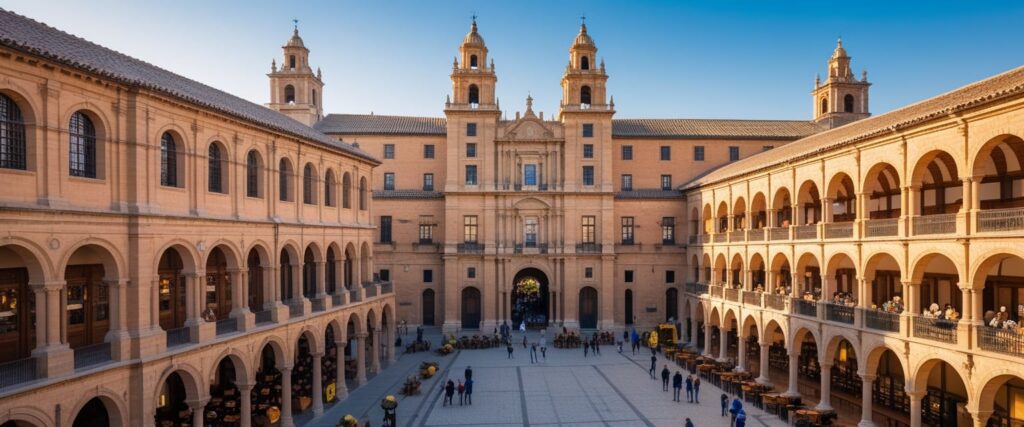
In the north, San Sebastián’s Parte Vieja and Monte Urgull provide scenic walks. The Basque Country also offers the old town of Casco Viejo in Bilbao.
Nature lovers can explore the Sierra Nevada mountains, the Tabernas Desert near Almería, or coastal cliffs near Girona along the Onyar River. These areas provide a quieter look at Spain’s landscapes.
Planning Your Spain Trip: Itineraries, Budget Tips, and Cultural Experiences
Travelers can enjoy Spain through carefully planned routes, affordable destinations, and unique cultural traditions. From historic cities and coastal escapes to food markets and lively festivals, each choice shapes how visitors experience the country.
10-Day Spain Itinerary Suggestions for 2025
A 10-day trip allows visitors to see both major cities and smaller towns without rushing. Many start in Barcelona, exploring Sagrada Familia and the Gothic Quarter, before heading to Valencia for paella and the City of Arts and Sciences.
From there, travelers often continue to Madrid, where the Prado Museum and Retiro Park stand out. Day trips to Toledo or Segovia add medieval charm and local specialties like marzipan.
The southern half of the trip usually includes Seville, famous for flamenco shows and tapas bars, and Granada, home to the Alhambra. Ending in Málaga gives access to beaches and Andalusian cuisine.

For alternate routes, a northern itinerary includes Bilbao, San Sebastián, and Logroño, focusing on pintxos and wine culture. Detailed sample routes can be found in this 10-day Spain itinerary guide.
Cheapest Places to Travel in Spain 2026
Spain offers several affordable destinations that balance culture and cost. Granada is known for free tapas with drinks and budget-friendly guesthouses. Valencia also provides good value, with inexpensive meals and lower hotel prices compared to Madrid or Barcelona.
In the north, Zaragoza offers historic sites like the Basílica del Pilar without high tourist costs. Córdoba is another option, where visitors can see the Mezquita and enjoy Andalusian patios at a fraction of the price of larger cities.
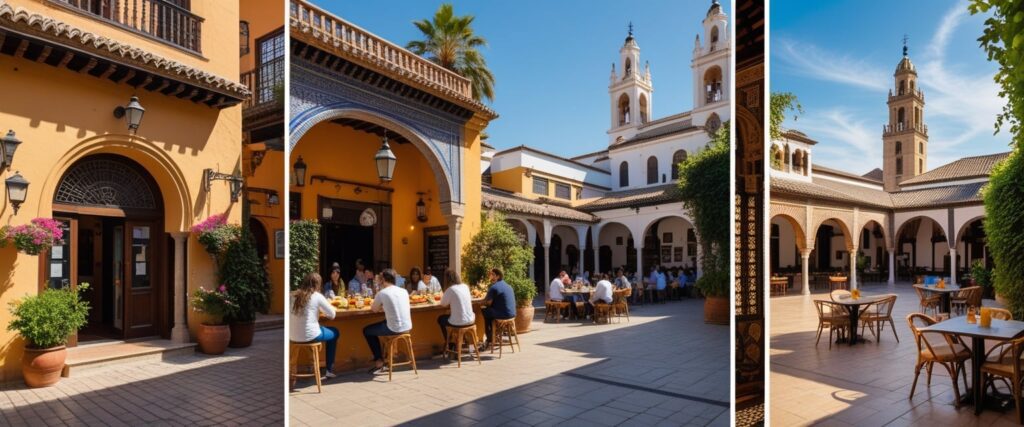
Travelers seeking beaches can choose Alicante or Cádiz, where accommodation and food are generally cheaper than in Ibiza or Marbella. According to guides like Nomadic Matt’s Spain travel tips, using buses and regional trains helps reduce costs further.
Beaches vs Cities: Which Experience Is Better?
Spain offers two very different experiences. Cities like Madrid and Barcelona provide museums, architecture, and nightlife. Visitors can enjoy tapas in traditional taverns, explore art galleries, or attend flamenco dancing performances in Seville.
Beaches, on the other hand, appeal to those who prefer relaxation. Costa del Sol, Costa Brava, and the Canary Islands feature sandy shores, seafood restaurants, and seaside promenades. Beach towns also tend to have a slower pace.
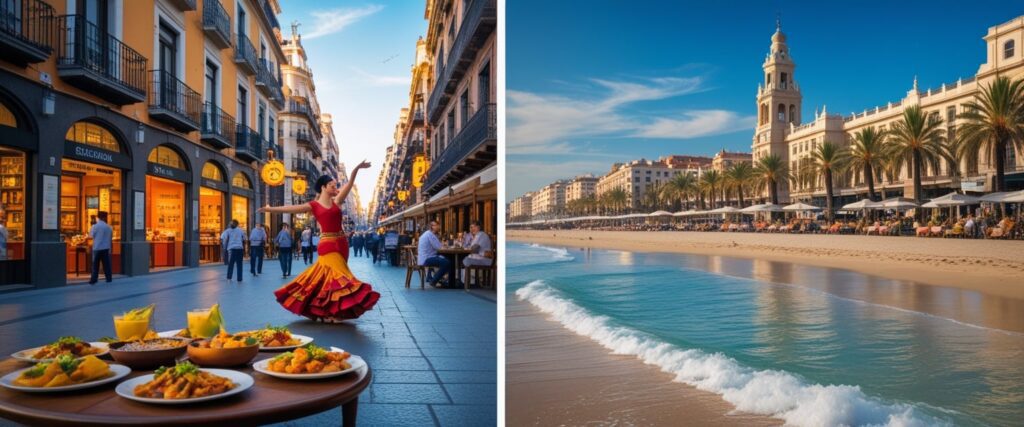
A balanced trip often combines both. For example, a traveler might spend a few days exploring Barcelona’s cultural sites before heading to Sitges or Valencia’s coastline. This mix allows for both urban discovery and time by the sea.
Cultural Festivals and Local Cuisine Highlights
Spain’s cultural calendar is filled with events that attract both locals and visitors. In 2025 and 2026, La Tomatina in Buñol, Semana Santa in Seville, and Las Fallas in Valencia remain key highlights. Each festival reflects regional traditions through parades, costumes, or fireworks.
Food is central to these experiences. Tapas and pintxos are everyday staples, with pintxo bars in the Basque Country offering small bites paired with local wine. In Valencia, paella is a must-try, while Andalusia is known for gazpacho and fried fish.
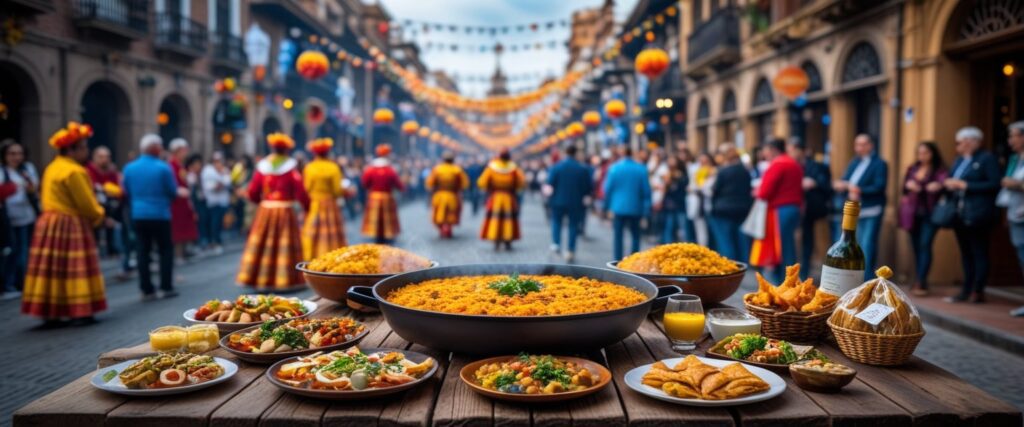
Even desserts carry tradition. Toledo is famous for marzipan, often sold in small shops near the cathedral. Pairing festival visits with regional foods ensures travelers experience Spain beyond its landmarks, connecting directly with its culture and people.
Conclusion
Exploring the Best Places to Visit in Spain 2025-2026 is more than a trip—it’s a complete cultural journey. From coastal escapes to historic treasures, the Best Places to Visit in Spain 2025-2026 showcase why Spain stands out as one of Europe’s most beloved destinations. Whether you choose vibrant Barcelona, historic Seville, or the hidden charm of Cuenca, the Best Places to Visit in Spain 2025-2026 promise endless discovery. Food, festivals, art, and architecture all blend seamlessly across the Best Places to Visit in Spain 2025-2026, giving every traveler unique memories.
Even budget-friendly cities like Granada and Valencia prove that the Best Places to Visit in Spain 2025-2026 can be enjoyed without breaking the bank. By balancing cities with beaches, and culture with relaxation, your journey through the Best Places to Visit in Spain 2025-2026 will feel complete. Now is the time to plan your adventure and experience the Best Places to Visit in Spain 2025-2026 in their full glory.
Frequently Asked Questions
What is the best time of year to visit Spain?
Most sources agree that spring and fall are ideal. Travel guides say that “March through May and September through November are generally the best times to visit Spain” due to warm weather and smaller crowds. Summer (June–August) is much hotter and busier, so many travelers prefer shoulder seasons.
How many days should I plan for a trip to Spain?
How many days should I plan for a trip to Spain?
Experts recommend 8–14 days to cover Spain’s highlights. Within this period you can see major cities like Barcelona, Madrid, Seville, and Granada, plus a few offbeat spots. In practice, 10 days is a popular itinerary length. (Shorter trips can hit 2–3 cities; longer stays allow time for quieter regions or neighboring Portugal/France.)
What are the top places and attractions to visit in Spain?
What are the top places and attractions to visit in Spain?
Spain’s must-see attractions include iconic landmarks like the Sagrada Família (Barcelona), Alhambra (Granada), and Park Güell (Barcelona), as well as world-class museums like Madrid’s Prado. Major cities frequently cited are Barcelona, Madrid, Seville, Granada, Valencia, Córdoba, and Bilbao. These destinations offer everything from Gothic quarters and royal palaces to Moorish architecture. (TravelOne specifically lists Sagrada Família, the Alhambra, Park Güell, the Prado, and Seville’s Plaza de España as top attractions.
What hidden gems or off-the-beaten-path places should I visit?
Beyond the big cities, travelers search for lesser-known spots. Guides suggest quiet villages and coastal coves – for example, Spain’s Costa Brava beaches or small inland towns – as authentic “hidden gems”. These areas are “not in big guidebooks or busy tourist areas” but offer a real taste of Spain. Examples include tiny mountain villages in Andalusia, the dramatic Picos de Europa range in the north, or Catalonia’s medieval town of Girona. (Mention that including one or two such spots in an itinerary can make it more unique.)
What is the average travel cost or budget for visiting Spain?
Spain is generally affordable. One guide calls it “one of the cheapest destinations in Europe”. A rough daily budget might be €90 per day for backpackers (hostels, street food, public transport) and €200–€250 per day for mid-range travelers. For example, nomadic travel sites estimate ~€90/day on a tight budget and about €215/day for a moderate budget. Smaller inland cities (e.g. Granada, Valencia, Zaragoza) often cost less than big tourist hubs. Look for “menú del día” deals (around €10) in many towns to stretch your budget.
Do I need a visa to travel to Spain?
Spain is in the Schengen Area. Citizens of the EU and many countries (including the US, Canada, UK, Australia, etc.) do not need a visa for short stays (up to 90 days in a 180-day period). In practice, U.S. and EU travelers can visit for tourism or business without a visa for up to three months. (Always double-check current entry rules, but generally, visa requirements are mild for short visits.)
Is Spain safe for travelers?
Is Spain safe for travelers?
Yes, Spain is broadly safe. Guides note that violent crime is rare, and the “warm, relaxed hospitality” makes most trips trouble-free. The main warning is to be mindful of petty theft: pickpocketing can be common in crowded tourist areas (e.g. La Rambla in Barcelona). Standard precautions (watch your belongings, especially on public transit) are advised.
What are some must-try Spanish foods or dishes?
Travelers love Spain’s cuisine. FAQs often list staples like paella (seafood rice), tapas (various small dishes), gazpacho (cold tomato soup), tortilla española (potato omelette) and churros con chocolate. Local specialties vary by region (try paella in Valencia, jamón ibérico in Andalusia, pintxos in the Basque country). Encouraging readers to sample these foods answers a common cultural question.
Which festivals or events should I know about in 2025–2026?
Spain’s festivals draw global interest. Trending questions include “what festivals are in Spain?” Notable events to mention are La Tomatina (the tomato-throwing festival in Buñol each August) and the Running of the Bulls in Pamplona each July. Semana Santa (Holy Week, March/April) – especially Seville’s processions – and Valencia’s Fallas festival (March) are huge draws. A travel site notes: “Some popular festivals in Spain include La Tomatina in Buñol, the Running of the Bulls in Pamplona, Semana Santa in Seville, and Feria de Abril in Seville.”. These cultural events often top travelers’ lists.
Should I focus on cities or beaches in Spain?
If addressing this query, note that both have appeal. City trips offer art, architecture and nightlife (Barcelona, Madrid, Seville, etc.), while beach trips (Costa del Sol, Costa Brava, Canary Islands) offer sun and relaxation. Many travelers mix both. (You can cite broad advice or personal guidance if needed, but authoritative sources rarely ask this exact question.)
